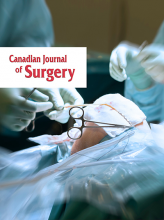“The most sophisticated intensive care becomes unnecessarily expensive terminal care once the pre-ICU system fails”
— Dr. Peter Safar.1
Seven years have passed since Canada ended its combat mission in Afghanistan and the Canadian Journal of Surgery published the first Canadian Forces supplement on war surgery.2 In the last decade, meticulous international data collection and research efforts have led to significant improvements in military trauma care. In optimal conditions, experienced health care providers can be challenged by trauma casualty care. Combat missions further complicate the challenge; the austere environment and scarcity of resources hinder optimal care to the wounded. Timely treatment is one of the most important variables that can affect trauma patients’ outcomes. Remote locations and tactical limitations may prolong evacuation times — a situation similar to trauma that occurs in remote locations in Canada under extreme weather conditions.
Historically, medical care in the battlefield has been a milieu for providers to learn and promote further trauma research in both military and civilian medical institutions. During both Iraq and Afghanistan conflicts, the establishment of clear injury definitions with quantifiable outcomes through detailed data collection and well-supported, focused research improved outcomes.3,4 Among the most significant improvements in tactical combat casualty care (TCCC) in recent years is the wide implementation of tourniquets, which decreased mortality from extremity hemorrhage by 85%.4 Hemostatic dressings with gauze impregnated with organic agents, such as chitosan or nonwoven kaolin, were found to be superior to regular gauze in controlling compressible hemorrhage.5 A significant cause of combat deaths is from noncompressible torso hemorrhage. Resuscitative endovascular balloon occlusion of the aorta (REBOA) has been used successfully in hospital settings to resuscitate those patients. In this supplement, Smith and McAlister6 present proof of concept for a novel REBOA system that may be used in the prehospital setting.
Early administration of tranexamic acid (TXA), which was shown in the CRASH-2 trial to reduce mortality,7 has been applied in combat situations. Balanced blood component transfusion, with a 1:1:1 ratio between red blood cells, plasma and platelets, became the gold standard for treatment of hemorrhagic trauma,8 but it is difficult to implement in austere or prehospital settings. Fresh whole blood donated by uninjured soldiers to a casualty in shock may be an effective strategy in austere circumstances to correct the various derangements caused by hemorrhage. Both TXA and fresh whole blood were used during the recent deployment in Iraq.9
Early surgery remains the key to providing medical care to trauma patients. The composition of forward surgical teams vary according to their designated mission from a team of approximately 20, including 4 surgeons, 8 nurses and 2 surgical technicians, to a 4-person jump team that consists of 1 to 2 surgeons, 1 nurse and 1 surgical technician.10 Leasiolagi and colleagues11 use their experience of a small team in a far-forward position that improvised a mobile operating room to define the specifications of an ideal unit.
The measures described above as well as improved personal protective equipment have resulted in better survivability, but combat wounds involving the extremities continue to be a problem. Smith and colleagues12 describe the greater injury severity present if an upper-extremity amputation is part of the polytrauma from improvised explosive devices as well as its consequences for rehabilitation. The Canadian Armed Forces physical rehabilitation program, built upon a civilian–military partnership, is described by Besemann and colleagues.13 The multidisciplinary team approach focuses on physical, psychosocial and spiritual aspects of a person’s well-being by empowering patients to foster self-efficacy, find meaning in life events and set high-level life goals. This holistic approach may be particularly necessary when suicide bombing is the mechanism of injury. A protocol for immediate actions by trauma teams to care for victims of suicide bombing is proposed in this supplement.14
Military trauma care has undergone a significant leap in recent years. Those new developments have impacted how NATO countries develop their core and enhanced field medical treatment facilities. More importantly, as described by DaCambra and colleagues,9 those experiences showed the importance of multinational interoperability and cooperation in effecting cohesive medical care in present and future coalition surgical facilities.9
Multinational interoperability derives from a unique relationship between higher medical command collaboration, international training and adherence to common standards for equipment and clinical practice. Furthermore, utilization of telemedicine technology to provide video calling for virtual consults has the potential to improve medical care where medical specialities are unavailable in an austere deployed setting. For example, Donham and Wickett15 discuss the case of a critically ill military working dog for whom veterinary services were limited and nonveterinary providers, through the use of FaceTime interactive video calling, consulted the dog’s veterinarian in the United States to assist in the evaluation, treatment and prioritization of medical evacuation.
Finally, the translation of research from the laboratory to the clinic has become a benchmark of success in medicine. The complexity of human physiology and its interaction with the environment warrant the development of safe and effective therapies. Kao and colleagues16 put forth a simple inhaled indomethacin to prevent worsening lung inflammation to acute respiratory distress syndrome in a blunt chest trauma rat model, which eventually can be evolved into practical application to human blunt chest trauma. It is through mutual learning in the battlefield, the laboratory and the civilian trauma environment that we continue to improve care to the injured and, ultimately save lives.
Footnotes
Competing interests: None declared.
Disclaimer: The views expressed in this paper are those of the authors and do not constitute the views or policies of the Canadian Armed Forces.






